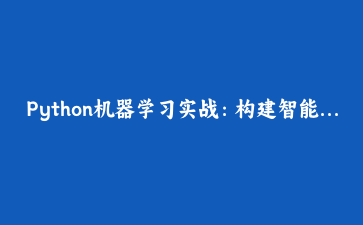掌握asyncio核心技术,构建高性能Python应用
为什么需要异步编程?
在现代应用开发中,I/O密集型任务(如网络请求、文件操作、数据库查询)往往成为性能瓶颈。异步编程通过非阻塞的方式处理这些任务,让CPU在等待I/O操作时能够执行其他任务,从而大幅提升程序效率。
🚀 性能提升
异步程序可以同时处理数千个网络连接,相比传统同步编程,性能提升可达数十倍。
💫 资源高效
单个线程即可处理大量并发任务,减少线程创建和上下文切换的开销。
⚡ 响应迅速
避免阻塞主线程,保持应用程序的响应性,提升用户体验。
异步编程核心概念
1. async/await 关键字
Python 3.5+ 引入的async和await关键字让异步编程变得更加直观和易于理解。
import asyncio
async def fetch_data(url):
# 模拟网络请求
print(f"开始获取 {url}")
await asyncio.sleep(2) # 模拟I/O操作
print(f"完成获取 {url}")
return f"{url} 的数据"
async def main():
# 创建多个异步任务
tasks = [
fetch_data("https://api.example.com/user"),
fetch_data("https://api.example.com/products"),
fetch_data("https://api.example.com/orders")
]
# 并发执行所有任务
results = await asyncio.gather(*tasks)
print("所有任务完成:", results)
# 运行异步程序
asyncio.run(main())
2. 事件循环 (Event Loop)
事件循环是异步编程的核心,负责调度和执行异步任务。
事件循环工作流程:
- 执行可运行的协程
- 处理已完成的任务
- 执行回调函数
- 处理I/O事件
- 重复循环直到所有任务完成
实战项目:构建异步Web爬虫
我们将创建一个高性能的异步Web爬虫,能够并发抓取多个网页并处理数据。
import asyncio
import aiohttp
from bs4 import BeautifulSoup
import time
import json
class AsyncWebCrawler:
def __init__(self, max_concurrent=10):
self.max_concurrent = max_concurrent
self.semaphore = asyncio.Semaphore(max_concurrent)
self.results = []
async def fetch_page(self, session, url):
async with self.semaphore:
try:
async with session.get(url, timeout=30) as response:
if response.status == 200:
html = await response.text()
return await self.parse_page(html, url)
else:
return {"url": url, "error": f"HTTP {response.status}"}
except Exception as e:
return {"url": url, "error": str(e)}
async def parse_page(self, html, url):
soup = BeautifulSoup(html, 'html.parser')
title = soup.find('title')
return {
"url": url,
"title": title.text.strip() if title else "No title",
"timestamp": time.time(),
"links_count": len(soup.find_all('a'))
}
async def crawl(self, urls):
async with aiohttp.ClientSession() as session:
tasks = [self.fetch_page(session, url) for url in urls]
self.results = await asyncio.gather(*tasks)
def save_results(self, filename):
with open(filename, 'w', encoding='utf-8') as f:
json.dump(self.results, f, ensure_ascii=False, indent=2)
# 使用示例
async def main():
urls = [
"https://httpbin.org/html",
"https://httpbin.org/json",
"https://httpbin.org/xml",
# 可以添加更多URL...
] * 3 # 重复URL以演示并发效果
crawler = AsyncWebCrawler(max_concurrent=5)
print("开始异步爬取...")
start_time = time.time()
await crawler.crawl(urls)
end_time = time.time()
print(f"爬取完成!总共处理 {len(urls)} 个URL")
print(f"耗时: {end_time - start_time:.2f} 秒")
# 保存结果
crawler.save_results("crawl_results.json")
print("结果已保存到 crawl_results.json")
# 运行爬虫
asyncio.run(main())
项目亮点:
- 并发控制:使用信号量限制最大并发数
- 错误处理:完善的异常捕获机制
- 性能监控:记录执行时间,评估性能提升
- 数据持久化:结果保存为JSON格式
高级模式与最佳实践
1. 异步上下文管理器
import aiofiles
class AsyncFileProcessor:
async def __aenter__(self):
self.processed_data = []
return self
async def process_file(self, filename):
async with aiofiles.open(filename, 'r') as f:
content = await f.read()
# 模拟处理过程
await asyncio.sleep(1)
processed = content.upper() # 示例处理
self.processed_data.append(processed)
return processed
async def __aexit__(self, exc_type, exc_val, exc_tb):
print(f"处理完成,共处理 {len(self.processed_data)} 个文件")
# 使用示例
async def process_files():
async with AsyncFileProcessor() as processor:
tasks = [processor.process_file(f"file{i}.txt") for i in range(3)]
results = await asyncio.gather(*tasks)
print("处理结果:", results)
2. 异步队列模式
使用asyncio.Queue实现生产者-消费者模式,处理数据流。
async def producer(queue, items):
for item in items:
await asyncio.sleep(0.1) # 模拟生产延迟
await queue.put(item)
print(f"生产: {item}")
await queue.put(None) # 结束信号
async def consumer(queue, name):
while True:
item = await queue.get()
if item is None:
queue.put(None) # 传递给其他消费者
break
await asyncio.sleep(0.2) # 模拟处理延迟
print(f"消费者 {name} 处理: {item}")
queue.task_done()
async def main():
queue = asyncio.Queue(maxsize=5)
items = range(10)
# 创建生产者和消费者任务
producer_task = asyncio.create_task(producer(queue, items))
consumer_tasks = [
asyncio.create_task(consumer(queue, f"Worker-{i}"))
for i in range(3)
]
await producer_task
await queue.join()
# 取消消费者任务
for task in consumer_tasks:
task.cancel()
🚀 开启异步编程之旅
掌握Python异步编程,让你的应用性能飞跃提升!













